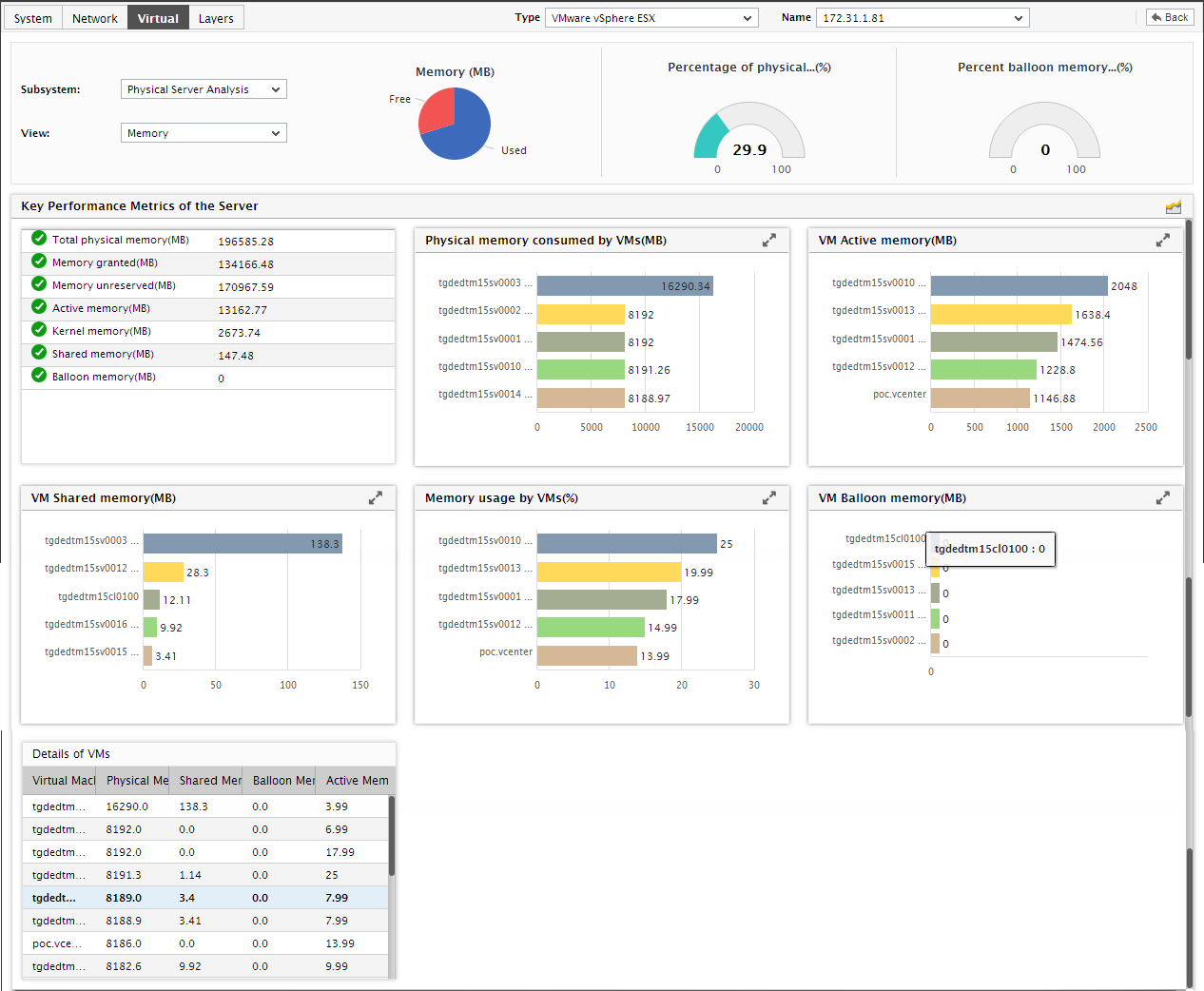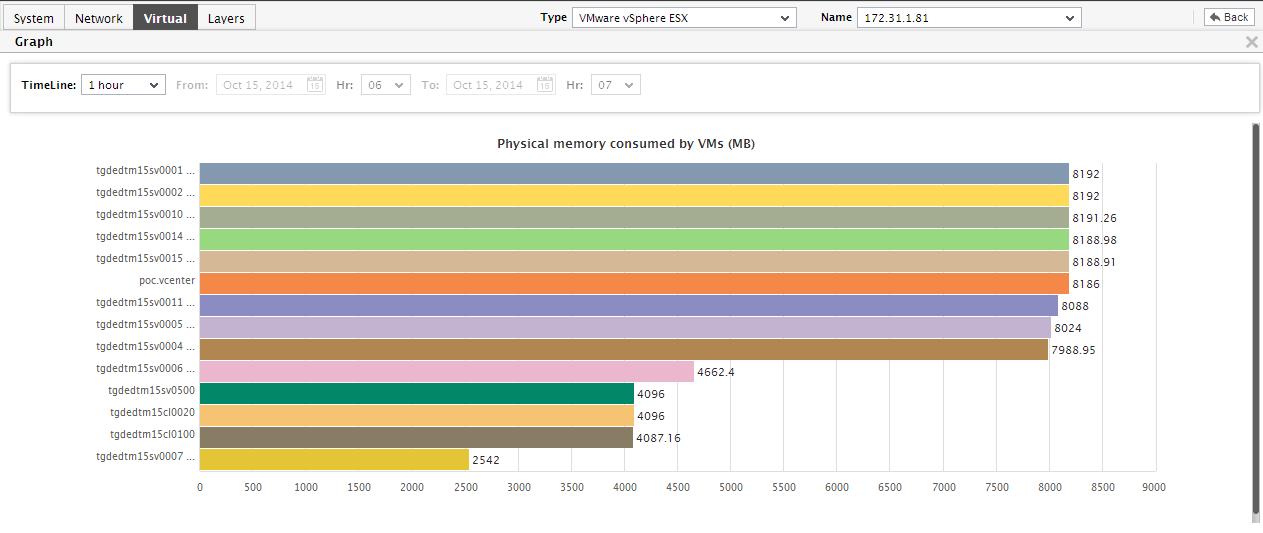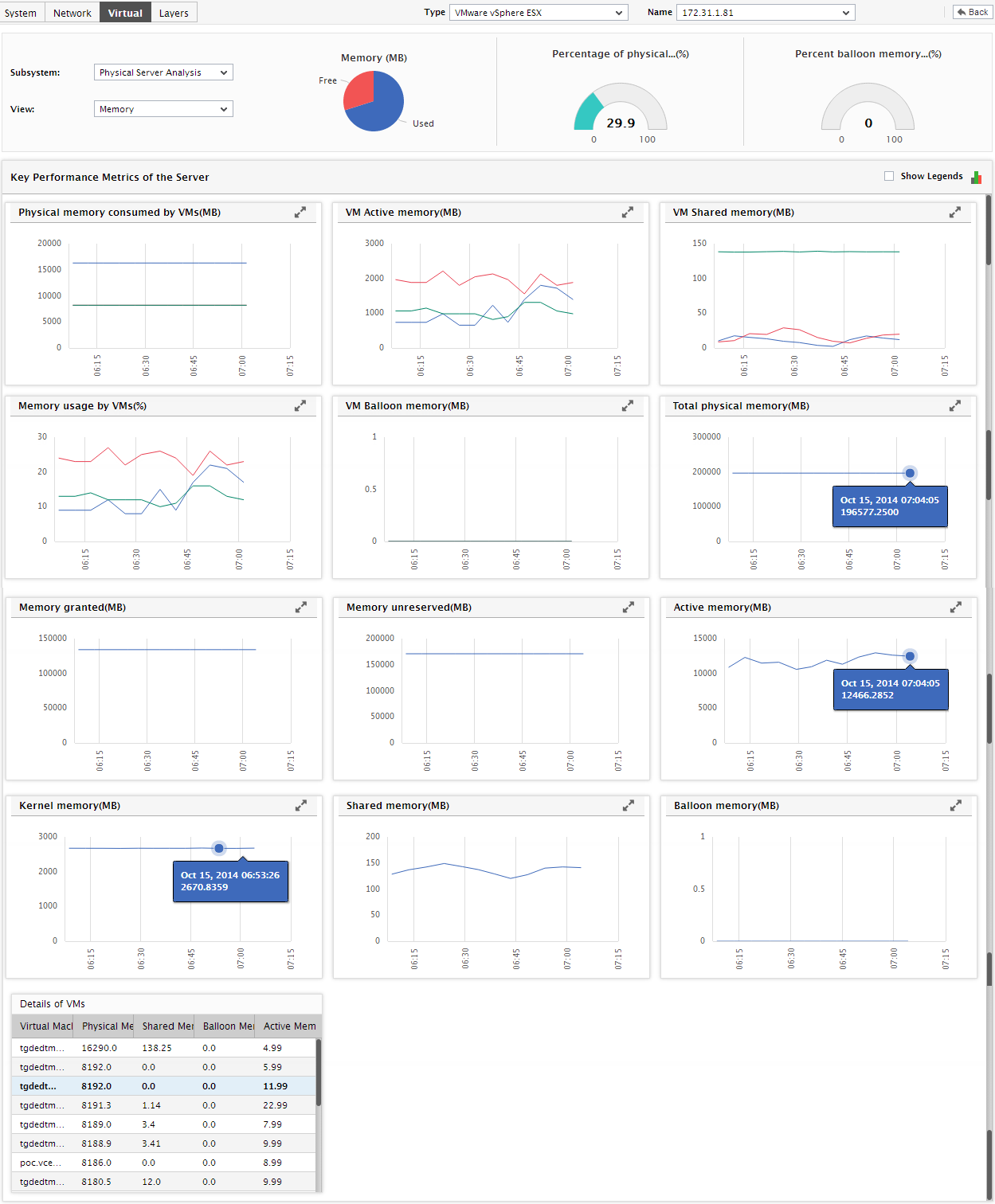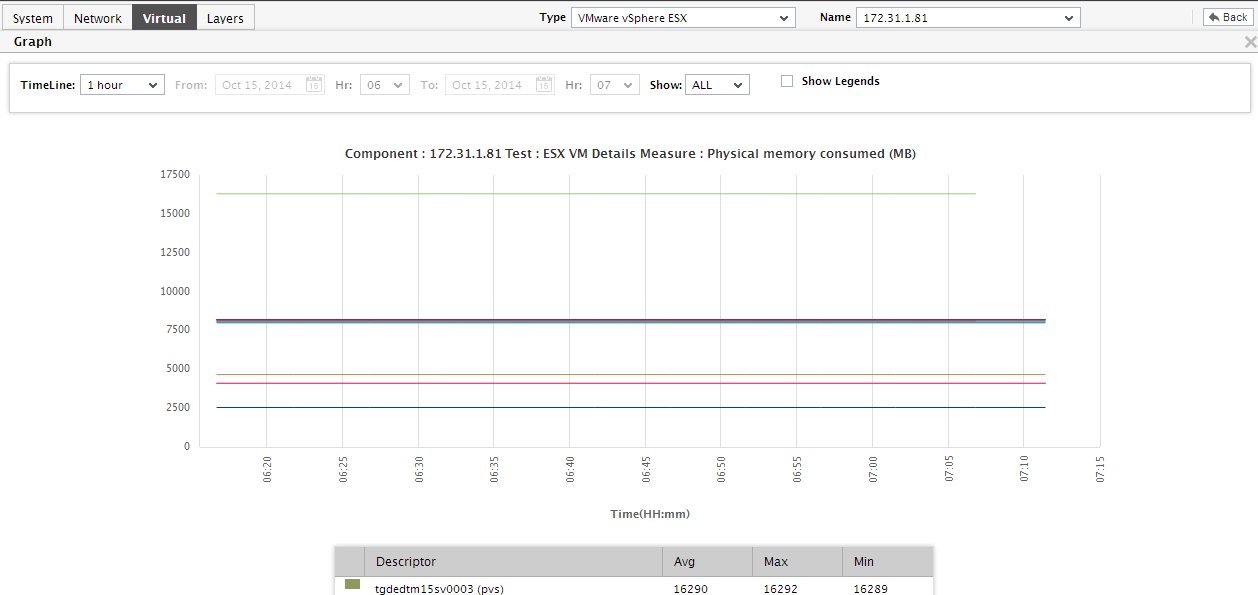Physical Server Analysis - Memory
To quickly analyze physical memory usage by the virtual host and its VMs, and to precisely point to the VMs that are eroding the memory resources of the host, select Memory from the View list. Figure 1 will then appear.

Figure 1 : The Physical Server Memory Analysis dashboard
The contents of Figure 1 have been detailed below:
-
A glance at the pie chart in the Memory dashboard will indicate to you whether a memory crunch exists on the host or not.
Note:
By default, the pie chart will denote the size of Free memory and Used Memory on the target virtual host. If you want the pie chart to represent more measures, do the following:
- Edit the eg_dashboard.ini file in the <EG_INSTALL_DIR>\manager\config directory.
-
In the [MemoryAnalysis] section of the file, you will find a parameter of the following format for each of the virtualization platforms that is being monitored by eG Enterprise:
<InternalComponentType>_PIE
This parameter is typically set to a comma-separated list of measures that will be represented in the pie chart in the Memory dashboard.
By default, this parameter is set to the Free memory and Used memory measures.
-
You can override this default setting by adding more measures to the comma-separated list, or by removing one/more existing measures. To add another measure, append an entry of the following format to the comma-separated list that follows the <InternalComponentType>_PIE parameter:
<InternalTest>:<InternalMeasure>:<DisplayName>
For instance, to make sure that the pie chart also represents the value of the Memory granted measure reported by the Memory - ESX test of the VMware vSphere ESX component, your entry should be: VmEsx_i_server_PIE=. . . . . . .,EsxMemoryTest:Memory_granted:Memory granted
To know the internal component type, test, and measure names, refer to page of this document.
-
Finally, save the file.
Note that dial charts can be used to represent only those measures that report values in percentage.
- The dial charts in the dashboard indicate the current state and values for critical memory usage metrics related to the host operating system. You can promptly detect sudden spikes in host's memory usage using these dial charts.
- Clicking on a dial chart will lead you to the Layer tab page, where you can view the layer and test that reported the measure represented by that dial chart.
-
Below the dial charts, you will find a table that indicates the current state and the current values for a default collection of critical memory usage-related metrics. This table allows you to focus on important usage metrics so that, you can instantly detect any change in the state of any such a metric, and immediately initial remedial steps.
Note:
If need be, you can alter the list of metrics that are displayed in this table by following the steps below:
- Edit the eg_dashboard.ini file in the <EG_INSTALL_DIR>\manager\config directory.
-
In the [MemoryAnalysis] section of the file, you will find a parameter of the following format for each of the virtualization platforms that is being monitored by eG Enterprise:
<InternalComponentType>_Memory_DATA
This parameter is typically set to a comma-separated list of measures that need to be included in the table of metrics in the Memory dashboard.
By default, this parameter is set to a pre-configured list of memory usage-related metrics extracted from the corresponding <InternalComponentType>.
-
You can override this default setting by adding more measures to the comma-separated list, or by removing one/more existing measures. To add another measure, append an entry of the following format to the comma-separated list that follows the <InternalComponentType>_Memory_DATA parameter:
<InternalTest>:<InternalMeasure>
For instance, to add the Free physical memory measure reported by the Memory - ESX test of the VMware vSphere ESX component, your entry should be: VmEsx_i_server_Memory_DATA =. . . . . . .,EsxMemoryTest:Machine_free_memory
To know the internal component type, test, and measure names, refer to page of this document.
- Finally, save the file.
-
Next to the table, you will find a default collection of comparison bar charts that typically compare physical memory usage across VMs. Using these graphs, memory-intensive VMs can be isolated.
Note:
You can configure what memory usage statistics need to be represented using the comparison bar charts, by following the steps discussed below:
- Edit the eg_dashboard.ini file in the <EG_INSTALL_DIR>\manager\config directory.
-
In the [MemoryAnalysis] section of the file, you will find a parameter of the following format for each of the virtualization platforms that is being monitored by eG Enterprise:
<InternalComponentType>
This parameter is typically set to a comma-separated list of measures for which comparison bar charts are to be displayed in the dashboard.
By default, this parameter is set to a pre-configured list of memory usage-related metrics extracted from the corresponding <InternalComponentType>.
-
You can override this default setting by adding more measures to the comma-separated list, or by removing one/more existing measures. To add another measure, append an entry of the following format to the comma-separated list that follows the <InternalComponentType> parameter:
<InternalTest>:<InternalMeasure>:<DisplayName>
For instance, to add a comparison graph for the Current swap memory measure reported by the EsxGuestDetails test of the VMware vSphere ESX component, your entry should be: VmEsx_i_server =. . . . . . .,EsxGuestTest:Swapped_memory:Swap memory
To know the internal component type, test, and measure names, refer to page of this document.
-
Finally, save the file.
It is recommended that you configure comparison graphs for only those measures that support descriptors.
-
If a comparison graph appears too cluttered, you can view that graph more clearly by enlarging it. To do so, click on that graph. Figure 2 will then appear as depicted below:

Figure 2 : Enlarging a comparison bar chart in the Physical Server Memory Analysis dashboard
- By default, in the enlarged mode, the comparison bar chart will display all the compared elements (i.e., descriptors). This is why, the Show list is set to all by default. If you want the graph to display only a few best or a few worst players in a particular area, then, pick a top-n or last-n option from the Show list.
-
Back in the dashboard, you will find that a Details of VMs table follows the comparison bar charts. By default, this table compares the physical and virtual memory usage of each of the VMs so that, you can clearly identify the following:
- The VM causing a severe dent in the physical memory resources of the host;
- The VM using the allocated memory resources excessively
By default, this table is sorted in the descending order of the Physical memory consumed column. To sort the table in the ascending order of the same column, click on the down arrow button that appears adjacent to the column heading, Physical memory consumed (GB). To sort the table on the basis of the values of another column, click on the title of the corresponding column.
Note:
You can configure additional measure columns for the Details of VMs table by following the procedure discussed below:
- Edit the eg_dashboard.ini file in the <EG_INSTALL_DIR>\manager\config directory.
-
In the [MemoryAnalysis] section of the file, you will find a parameter of the following format for each of the virtualization platforms that is being monitored by eG Enterprise:
<InternalComponentType>_DATA
This parameter is typically set to a comma-separated list of measures that will appear as columns in the Details of VMs table.
By default, this parameter is set to a pre-configured list of memory usage statistics extracted from each VM on the corresponding <InternalComponentType>.
-
You can override this default setting by adding more measures to the comma-separated list, or by removing one/more existing measures. To add another measure, append an entry of the following format to the comma-separated list that follows the <InternalComponentType>_DATA parameter:
<InternalTest>:<InternalMeasure>
For instance, to add a column for the Current swap memory measure reported by the EsxGuestDetails test of the VMware vSphere ESX component, your entry should be: VmEsx_i_server_DATA =. . . . . . .,EsxGuestTest:Swapped_memory
To know the internal component type, test, and measure names, refer to page of this document.
- Finally, save the file.
-
To historically analyze the physical memory usage of the host and the VMs, you can view historical measure graphs in your dashboard, instead of the default comparison bar charts. To do this, click on the
 icon at the right, top corner of your dashboard. This will result in the display of measure graphs, plotted for a default duration of 1 hour, for each of the measures for which comparison bar charts were originally displayed.
icon at the right, top corner of your dashboard. This will result in the display of measure graphs, plotted for a default duration of 1 hour, for each of the measures for which comparison bar charts were originally displayed. 
Figure 3 : Viewing historical measure graphs in the Physical Server Memory Analysis dashboard
- In the event of a contention for memory resources, you can use these measure graphs to understand how memory was used during the last hour, and when the memory erosion actually began.
-
To view a measure graph more clearly, click on it. This will enlarge the graph (see Figure 4).

Figure 4 : Enlarging a measure graph in the Physical Server Memory Analysis dashboard
- In the enlarged mode, you can change the Timeline of the graph. You can also pick a top-n or last-n option from the Show list to analyze the time-of-day variations in the performance of a few best/worst players in the chosen performance arena. To return to the dashboard, click on the enlarged graph.
